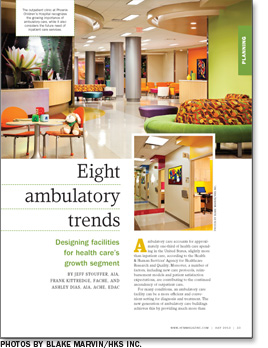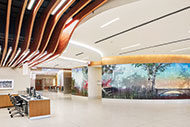 Ambulatory care accounts for approximately one-third of health care spending in the United States, slightly more than inpatient care, according to the Health & Human Services' Agency for Healthcare Research and Quality. Moreover, a number of factors, including new care protocols, reimbursement models and patient satisfaction expectations, are contributing to the continued ascendency of outpatient care.
Ambulatory care accounts for approximately one-third of health care spending in the United States, slightly more than inpatient care, according to the Health & Human Services' Agency for Healthcare Research and Quality. Moreover, a number of factors, including new care protocols, reimbursement models and patient satisfaction expectations, are contributing to the continued ascendency of outpatient care.
For many conditions, an ambulatory care facility can be a more efficient and convenient setting for diagnosis and treatment. The new generation of ambulatory care buildings achieves this by providing much more than clinic space. The latest designs encourage continuous improvement; accommodate changing care practices, technologies and relationships between physicians and hospitals; meet the needs of a growing, more urbanized population; provide services that attract new patients to health systems; and even take into consideration the requirements of future inpatients.
Careful planning
Like traditional hospital buildings, ambulatory facilities require careful planning that matches the physical environment to the needs of the community as efficiently as possible. Eight of the leading ambulatory care design trends include:
You may also like |
| Managing facilities for population health |
| A new generation of ambulatory facilities |
| Alternatives for outpatient construction |
| |
1 Lean process improvement. Improving patient throughput is key to maximizing any health care organization's facility assets. Lean process improvement provides a number of tools to help people perform better and more efficiently. In the health care setting, this means increasing throughput while maintaining quality. By defining Lean operational parameters and utilizing Lean design and construction techniques, a hospital or health system can boost the inherent efficiencies of ambulatory care.
To establish a baseline for advancement, the first step of any process improvement project is to define the current state of operations. Industry trends, best practices, benchmarks and metrics are useful in defining the desired future state.
In developing a Lean facility design, it is important to focus initially on improving operations, apart from making any physical improvements. Once Lean processes are established, an organization can begin looking at how physical improvements might further enable operational improvements. Form should follow function, but function also follows form. Since the two overlap, it is necessary to take an iterative approach that considers both. Cleaned up processes only go so far in a less-than-ideal space, and a cleaned up space gives process improvement an environment in which to flourish.
Simulation models and departmental mock-ups are helpful tools in achieving Lean designs. Static simulation involves a relatively simple spreadsheet model that demonstrates what happens when changes are made to throughput metrics and design. Dynamic simulations are more sophisticated, computer-based models with multiple variables, which can be used to begin refining processes and physical designs.
Departmental mock-ups, from early cardboard layouts to full-scale, fully fitted-out displays, allow staff to visualize and run actual process scenarios to determine the best design for the most efficient operational flow. Scenario testing lets staff try out design and workflow ideas before potentially costly mistakes are built into the facility.
2 Shared medical appointments. Also known as group visits, these gatherings address the health care needs of several people at once. This type of care can be efficient and effective for certain patient populations, such as obstetrics patients. It also has shown to be helpful in disease management, for conditions like diabetes. Patient education and wellness programs also can be accomplished in a group visit setting.
Most ambulatory environments are not currently set up to accommodate these types of visits. New ambulatory care designs should consider the need for group visit space within the facility, along with areas where caregivers and patients can interact.
The projected impact of group visits on patient throughput also should be taken into account. While these appointments involve multiple patients, they are typically longer than individual appointments. The Cleveland Clinic, for example, reports that individual appointments at the clinic last 15 to 30 minutes, compared with 90 minutes for shared medical appointments. Depending on a health care organization's situation, this may increase or decrease throughput. Space and staffing requirements should be calculated accordingly.
3 Telehealth services. Technological advances have made home care via e-visits and other telehealth solutions a viable component of outpatient care. Telehealth is the use of electronic means to provide health care to patients who are outside the health care setting. The technologies involved can range from a simple phone call or email exchange to videoconferencing, streaming media, remote monitoring and robotics.

E-visits, one aspect of telehealth, are really taking off. These virtual visits are a convenient means for an established patient to discuss a specific health care issue, such as a minor illness or well-controlled chronic condition, with a caregiver without the patient's having to leave home. Instead of going to see a doctor or nurse practitioner in person, the patient can exchange messages with the caregiver via a secure electronic communications portal. E-visits also are covered by some insurers.
There are two models for e-visits: synchronous, in which the physician and patient communicate directly with one another in real time; and asynchronous, in which the physician and patient can post messages for one another at different times.
The design implications of e-visits and other telehealth solutions depend on the level at which a health care organization plans to provide this type of service. Digital exam rooms with the appropriate equipment, lighting and acoustics are essential for successful telehealth implementation. Design teams should consider the impact of telehealth services on patient throughput and the number of full- and part-time employees needed to manage these systems.
4 Hospital-employed physicians. With reimbursement models changing, physicians are seeing the benefit of joining larger groups. More and more, they are becoming employees of hospitals, working at hospital-based ambulatory clinics.
In "Health Reform and the Decline of Physician Private Practice," a 2010 white paper published by Merritt Hawkins and the Physicians Foundation, a nonprofit research and advocacy group for practicing physicians in Bonita Springs, Fla., it is projected that with the advent of health reform, "most physicians will be compelled to consolidate with other practitioners, become hospital employees, or align with large hospitals and health systems for capital, administrative and technical resources."
One provision of the health reform act is the establishment of accountable care organizations (ACOs), provider groups that can receive financial incentives from the Centers for Medicare & Medicaid Services for meeting quality and efficiency goals. To participate in the Medicare Shared Savings Program, ACOs must have a sufficient number of primary care professionals to cover at least 5,000 Medicare beneficiaries. It is likely this number will be easier to track for ambulatory networks that include employed physicians.
Ambulatory care facilities for hospital-employed physicians generally include large areas for collaborative work because this type of practice emphasizes collaboration. The more standardized practices of hospital-employed physicians lend themselves well to modular clinic designs that make efficient use of space.
5 Flexibility for the future. Facility design represents a long-term investment for health care organizations. To make the most of this investment, it is essential to identify future care processes and then standardize the design as much as possible to enable the building to adapt to future needs that can be predicted and those that cannot.
To help predict future needs, an organization first should attempt to recognize and correct current inefficiencies to streamline processes and make better use of space. This can maximize the organization's immediate space utilization and reduce the need for total space in the future. Studying how other groups are delivering care can provide a useful outside perspective on the possibilities for process and facility design.
Organizations should consider the types of patient visits they plan to offer and include appropriate exam rooms for each. If group or e-visits are projected to be part of the mix, the design should include areas that meet the needs of these services.
Benchmarks are valuable in determining current and future needs. Because some specialties have a higher patient throughput than others, the number of exam rooms per physician per specialty is a particularly worthwhile metric for ambulatory care design. The number of half-days a clinic meets is also important. Clinics that meet at least four half-days a week typically are provided with dedicated space. Surgical and general medical subspecialties often can share space, for example, with each meeting three days a week in the same clinic.
Standardized clinic modules designed to function efficiently for a variety of providers allow health care organizations to adapt if patient volumes shift from one specialty to another down the road.
6 Population-growth tracking. Health systems are recognizing the value of tracking population changes in their markets and facility design requests for proposals are beginning to include questions about how organizations' real estate strategies should anticipate population growth or movement.
For the past 20 years, health systems typically have followed a hub-and-spoke model for ambulatory care that features hospitals in city centers, with satellite ambulatory care centers in suburban locations. As the U.S. population becomes more urbanized, the outpatient needs of urban dwellers should be addressed with more convenient locations. A modified hub-and-spoke system with layered spokes, some of which do not extend all the way to the suburbs, can help providers serve everyone in the service area.
This is especially important to health care systems because ambulatory care is like the heart and limbs of the continuum of care. Everyone pulses through ambulatory care — all ages and types of people from every part of a geographic area.
7 Combined urgent care centers and ambulatory clinics. Urgent care centers serve unscheduled primary care needs — situations for which a patient cannot wait days or weeks for an appointment to see a caregiver, but that do not require emergency treatment. Health systems can gain several benefits by combining ambulatory and urgent care services in the same facility.
The urgent care center can take the stress off the hospital emergency department (ED) by diverting nonemergency patients to a more appropriate care setting. Urgent care centers also present opportunities to bring more individuals into a health system. With the right design, an urgent care department can even be built to convert into an ED for a future satellite hospital.
8 Inpatient needs. Despite the recent shift from inpatient to outpatient care, organizations should not disregard the fact that an ambulatory facility may one day need to handle more acute patients. Ambulatory surgery centers already are moving toward accommodating higher-acuity outpatient surgeries, which require more of an inpatient mindset during design, especially regarding post-anesthesia care.
Looking ahead
Look into the future and see what the ambulatory facility might become, and then look at what the health care organization needs and can afford today.
By working with both these poles in mind, project teams can create facilities that will respond well to today's health care design trends as well as those to come.
Jeff Stouffer, AIA, is principal and practice leader of health care design, HKS Inc.; Frank Kittredge, FACHE, is principal and director, HKS Knox Advisors; and Ashley Dias, AIA, ACHE, EDAC, is health care planner at HKS Inc. They can be reached at jstouffer@hksinc.com, fkittredge@hksinc.com and adias@hksinc.com.
| Sidebar - Current challenges for outpatient care |
| The capacity of the nation's ambulatory care system is overwhelmed. Due to an increasing number of patients and a shortage of caregivers, wait times are getting longer. It can take weeks for a patient to gain access to a physician; appointments, especially those for specialty care, frequently must be scheduled well in advance. On the day of an appointment, patients often spend additional time waiting to be seen. As the United States becomes more urbanized, population concentrations are intensifying, putting more strain on the system. Difficulties accessing care are causing patient loyalty to wane. Many of today's patients are informed about their health care options and will not automatically return to the same physician or network, particularly if they can see someone else sooner. A large number of mergers and acquisitions among health care providers, which can make it difficult to follow exactly what organization is providing the care, also negatively impact patient loyalty. So does poor health network design. The outpatient care system also must recognize the unique attributes and needs of pediatric and adult patients. On the whole, pediatric patients require more time from caregivers than do their adult counterparts. And smaller patients generally need larger facilities because children are often accompanied by more than one adult and siblings, too. Sedation spaces may be required for pediatric outpatient procedures Health providers need to tailor their facilities and operations to serve each patient population accordingly. |
| Sidebar - Reform's impact on the outpatient setting |
| The Affordable Care Act (ACA) will influence ambulatory care in several ways. In general, more comprehensive health coverage will bring a large volume of new patients into the crowded health care arena. More specifically, the law will affect how care is delivered. The ACA provides for the establishment of the Medicare Shared Savings Program, which is intended to coordinate care among Medicare providers and reduce unnecessary expenses. According to the Centers for Medicare & Medicaid Services (CMS), the program is designed to produce better outcomes and lower costs, in part by encouraging investment in infrastructure and redesigned care processes. To participate in the program, providers must join an Accountable Care Organization (ACO). ACOs will be rewarded based on savings and performance benchmarks. The rules governing ACOs require them to have a sufficient number of primary care professionals for at least 5,000 Medicare beneficiaries. CMS' Bundled Payments for Care Improvement initiative, which launches this year, groups payments by episodes of care (for example, care related to a stroke). This initiative requires coordination between inpatient and outpatient settings. Likewise, the Hospital Readmissions Reduction Program penalizes hospitals determined by CMS to have an excessive number of patients readmitted within 30 days of discharge. Outpatient follow-up care is critical to avoid the need for readmission. Wellness care can prevent people from needing to be hospitalized in the first place. As low-cost, high-value care options continue to be emphasized, wellness management for beneficiary populations will increase in importance. |





